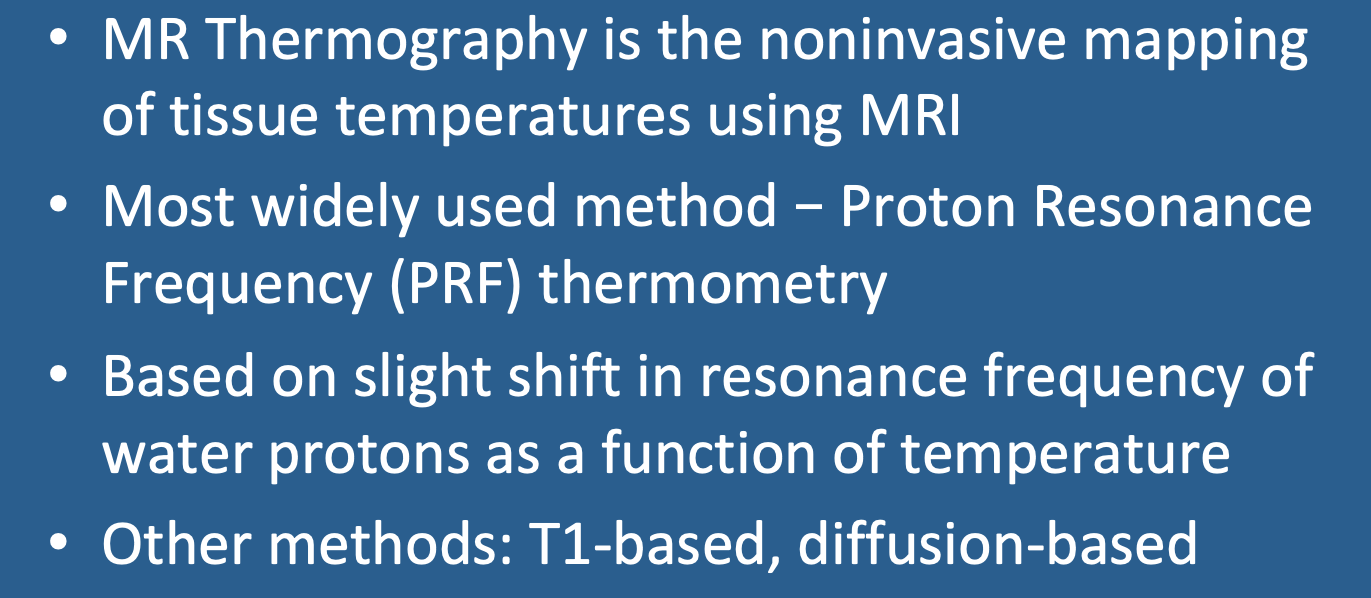In addition to evaluating heating around implants in vivo, MR can provide real-time noninvasive temperature mapping for thermal tissue ablation procedures and other therapies.
Proton Resonance Frequency (PRF) Thermometry
The most widely used method, Proton Resonance Frequency (PRF) MR Thermometry, is based on the observation that the resonance frequency of water protons decreases with increasing temperature. The temperature dependence is approximately 0.01 ppm/ºC. So at 1.5T (where the fo = 64 Mz), a 10 ºC rise in temperature would result in about a 6.4 Hz decrease in resonance frequency.
To understand why this happens, you must be familiar with the concept of chemical shift. (See this Q&A for a quick review). In brief, the precise resonance frequency of an ¹H nucleus depends on its local molecular environment. Nuclei surrounded by a dense cloud of electrons will be shielded from the full effect of the externally applied magnetic field (Bo), experiencing a smaller local field (Bloc) and resonating at a slightly lower frequency.
|
In water hydrogen bonding occurs when the hydrogen atom of one molecule interacts with the oxygen atom of another. During this process, some of the original hydrogen's electron cloud is pulled away by the nearby electrophilic oxygen atom. Being so deshielded, the hydrogen-bonded ¹H nucleus thus experiences a relatively stronger local field than in its non-bonded state. Increasing temperature stretches/bends/ disrupts hydrogen bonding, leaving more ¹H protons better shielded with correspondingly lower frequencies.
|
|
To produce thermometry images like that shown left, common practice is to use a spoiled gradient echo sequence to acquire phase maps of tissue before and after heating. By subtracting the two image sets, chemical shift effects that are not temperature-dependent are removed. The resulting phase-change (Δϕ) map has pixel values proportional to the change in temperature (ΔT).
The strength of the PRF method is that the recorded phase change is linear over a wide range of temperatures and tissue types (excluding those containing large quantities of fat). Additional challenges include thermodynamic changes in susceptibility, electrical properties, and blood volume/perfusion that are not captured in the model. |
T1-Relaxation MR Thermometry
T1-based methods were among the earliest approaches use in MR thermography, and still find application today especially in fat-containing tissues where PRF methods cannot be used. In most tissues, T1 times increase with increasing temperature (since the primary mechanism of T1 relaxation is due to thermal interactions with surrounding molecules). An approximately linear dependence of ΔT1 and ΔTemp occurs in the physiologic range, so measuring changes in T1 times after heating allow tissue temperature to be estimated. However, both T1 and its temperature dependence vary among different tissues and become nonlinear when tissue coagulation occurs. The T1-temperature effect is reduced at high fields.
Other MR Thermometry Methods
These include diffusion, magnetization transfer, proton density, T2, spectroscopy, and temperature-sensitive contrast agents, all of which are discussed in the references below.
Advanced Discussion (show/hide)»
No supplementary material yet. Check back soon!
References
Blackwell J, Krasny MJ, O’Brien A, et al. Proton resonance frequency shift thermometry: a review of modern clinical practices. J Magn Reson Imaging 2020 (in press) [DOI Link]
Dehkharghani S, Qiu D. MR thermometry in cerebrovascular disease: physiologic basis, hemodynamic dependence, and a new frontier in stroke imaging. AJNR Am J Neuroradiol 2020; 41:555-565. [DOI Link]
Hindman J. Proton resonance shift of water in the gas and liquid states. J Chem Phys 1966; 44:4582-4592. (first description of temperature dependence and mechanism of PRF) [DOI Link]
Ishihara Y, Calderon A, Watanabe H, et al. A precise and fast temperature mapping using water proton chemical shift. Magn Reson Med 1995; 34:814-823. [DOI Link]
Odéen H, Parker DL. Magnetic resonance thermometry and its biological applications – Physical principles and practical considerations. Prog NMR Spectroscopy 2019; 110:34-61. [DOI link]
Parker DL, Smith V, Sheldon P, et al. Temperature distribution measurements in two-dimensional NMR imaging. Med Phys 1983; 10:321–25. [DOI Link] (one of the first papers on MR thermography, using temperature-dependent T1-increases as a predictor)
Semonche A, Luther E, Berry K, et al. MR-guided laser interstitial thermal therapy for treatment of brain tumors. In: Scerrati A, De Bonis P (Eds). Neurosurgical Procedures - Innovative Approaches. Intechopen, 2019. [DOI Link]
Winter L, Oberacker E, Paul K, et al. Magnetic resonance thermometry: methodology, pitfalls and practical solutions. Int J Hyperthermia 2016; 32:63-75. [DOI Link]
Blackwell J, Krasny MJ, O’Brien A, et al. Proton resonance frequency shift thermometry: a review of modern clinical practices. J Magn Reson Imaging 2020 (in press) [DOI Link]
Dehkharghani S, Qiu D. MR thermometry in cerebrovascular disease: physiologic basis, hemodynamic dependence, and a new frontier in stroke imaging. AJNR Am J Neuroradiol 2020; 41:555-565. [DOI Link]
Hindman J. Proton resonance shift of water in the gas and liquid states. J Chem Phys 1966; 44:4582-4592. (first description of temperature dependence and mechanism of PRF) [DOI Link]
Ishihara Y, Calderon A, Watanabe H, et al. A precise and fast temperature mapping using water proton chemical shift. Magn Reson Med 1995; 34:814-823. [DOI Link]
Odéen H, Parker DL. Magnetic resonance thermometry and its biological applications – Physical principles and practical considerations. Prog NMR Spectroscopy 2019; 110:34-61. [DOI link]
Parker DL, Smith V, Sheldon P, et al. Temperature distribution measurements in two-dimensional NMR imaging. Med Phys 1983; 10:321–25. [DOI Link] (one of the first papers on MR thermography, using temperature-dependent T1-increases as a predictor)
Semonche A, Luther E, Berry K, et al. MR-guided laser interstitial thermal therapy for treatment of brain tumors. In: Scerrati A, De Bonis P (Eds). Neurosurgical Procedures - Innovative Approaches. Intechopen, 2019. [DOI Link]
Winter L, Oberacker E, Paul K, et al. Magnetic resonance thermometry: methodology, pitfalls and practical solutions. Int J Hyperthermia 2016; 32:63-75. [DOI Link]
Related Questions
What is meant by a chemical shift?
What is meant by a chemical shift?


